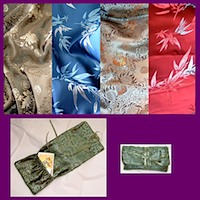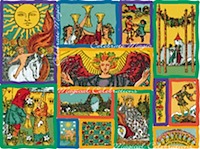By Jeanne Fiorini
After holiday celebrations which might have left you with much more family time than you bargained for, the title “Relativity” could have you running for the hills.
Not to worry, this month’s column is not about relatives.
This article was generated, however, by another experience which can cause apprehension in the hearts of mature adults: a visit to the dentist’s chair. You’ve got to give them credit these days, dentists do much to (try to) alleviate the anxiety of their customers. You can get headphones, a neck pillow, and/or various controlled substances to make the time spent (and I do mean spent) at their offices more tolerable.
My dentist is a pretty good guy actually, and my aversion to dentistry has nothing to do with him. During a recent visit, while in that reclining chair awaiting the doctor and his sharp instruments, I couldn’t help but rest nervous eyes upon the only object in my line of sight: a Calder-esque mobile featuring black fish of various sizes. The gently shifting movement of the shapes gliding through the air was indeed quite mesmerizing.
It occurred to me that the mobile was not only fulfilling its intended purpose of lulling patients into unintentional calm, it was at the same time satisfying its more fundamental nature as a work of art perpetually “in process.” It really is quite a remarkable concept with which Alexander Calder is credited: the notion of sculpture in motion, of abstract forms continually creating new realities, the idea that when a three-dimensional form becomes integrated with the element of time, a four-dimensional work of art is created. Now that’s a leap of consciousness!
Calder, ingenious and inventive as he was, was also a product of his times. His groundbreaking work during the mid-20th century reflects shifts in the collective consciousnesses toward concepts which have become solidified in our “heritage of awareness.” One could say that the events of the first half of the 20th century changed forever how humans would think.
We’ve got Sigmund Freud at the beginning of the century, with Carl Jung hot on his heels, poking around in the unconscious, defining the nature of the human psyche, and making “psychoanalysis” a household word. Albert Einstein comes along, in 1921 winning the Nobel Prize for his services to theoretical physics, and states that time is relative, outer space is curved, and energy is infinite. Pluto, known to latter-day astrologers as the planet of transpersonal wisdom and destiny, is discovered in 1930. (Whether or not it is still considered a planet is irrelevant; Pluto remains very, very far from Earth.)
The 1930’s and the 1940’s see the development and detonation of the first atomic bombs…talk about a mind-blower. Not surprisingly, existentialism peaks during the following decades. Investigations into what will in future years be called “quantum physics” are being conducted in Europe and America.
The mechanistic world views of previous centuries didn’t stand a chance. “Relativity” became the new reality, and we still are grappling with what that means. Even as one sits in a dentist’s chair in the year 2009, the fact that reality is an emerging, evolving, work in progress still comes as a bit of a surprise.
While sitting in that chair, I found myself admiring-- and then envying-- those black fish as they floated along, unperturbed by their constant movement through space and all the while adjusting effortlessly to the movements of all the other black fish in that particular fish universe. It would be a personal goal of mine for 2010 to build some of that “easy fish movement” into my life.
As I awaited the mean man and his needles and continued to observe the black fish gliding through the air with the greatest of ease, it dawned on me what a phenomenal barometer of relativity the Tarot is. (Apparently, if you read Tarot for a living, any new thought will eventually be boiled down to how it relates to the Tarot!)
The whole process of learning and reading Tarot is, from beginning to end, an ongoing exercise in relativity. Think about it:
- The cards each have a “field of meaning” but no one card has only one single interpretation.
- The intrinsic “meaning” of any one card is ultimately determined by the reader’s belief systems and world view.
- The interpretation of any one card is influenced by all the other cards which appear along with it.
- The interpretation of any one card is effected by the reader’s—as well as the querent’s -- world views and belief systems.
- The interpretation of any one card is effected by the nature of the query for which it has been drawn.
“What does Card X mean?” It depends. “Does Card X always mean the same thing?” Not really. “What does it mean when Card X appears with Card Y?” It depends. “Does Card X mean the same thing to everyone?” Not necessarily. “When is Card X a positive thing and when is it negative thing?” I don’t know.
Honestly, how do we manage it?!
We manage it by establishing a solid base of Tarot knowledge, developing an intimate relationship with intuition, and maintaining a feel for the relativity of the moment.
That is the art of Tarot. This is what makes it so wonderful, and so difficult. It’s a lot of balls to keep in the air while still coming up with a comprehensible interpretation. Readers, congratulate yourselves!
It probably hasn’t escaped some of you that the first mass-produced Tarot deck, the now-familiar Rider-Waite (Smith) deck, was published in 1910. Is it a coincidence that something which became a worldwide phenomenon of learning and intuition emerged just as 20th century consciousness began to shift into another gear? Not in my reality.


